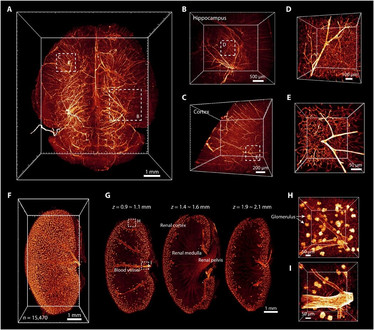FDISCO
A new tool in the pathologist’s arsenal may allow 3D imaging of tissues and organs.
It’s a pathologist’s wildest dream – the study of tissue without the need for labor-intensive, error-prone histological sectioning. A new paper in Science Advances (1) builds on recent advances in tissue optical clearing (2) to present a new approach to the three-dimensional imaging of whole organs – FDISCO.
Professor Dan Zhu is one of the project leads based at the Huazhong University of Science and Technology in Wuhan, China. He believes the new approach overcomes some serious limitations facing the field. “We wanted to maintain the advantages of original 3D imaging of solvent-cleared organs (3DISCO) in tissue transparency and tissue shrinkage,” he explains, “but we wanted to better preserve the fluorescence signals, which are quickly quenched in current approaches.”
To preserve fluorescence, the team modified the experimental conditions by reducing the temperature and generating an alkaline pH. Zhu believes these alterations might reduce the sensitivity of green fluorescent protein (GFP) to denaturation by tetrahydrofuran, a dehydration agent. This has given FDISCO major advantages over other clearing methods, he says. “It can simultaneously achieve a higher level of tissue transparency, substantial tissue shrinkage, and excellent fluorescent preservation.”

FDISCO allowed the team to image the 3D structures of the brain (a-e) and kidney (f-i) using fluorescent dyes. (Reproduced from [1.] with the permission of the authors)
FDISCO does have some limitations. Lipophilic dyes, such as DiI stain, are incompatible with the approach because they are dissolved by the clearing agents. It’s also difficult to achieve high levels of transparency in heme-rich tissues like the spleen, because of residual blood that blocks light penetration, but Zhu thinks this can be addressed by introducing decolorizing reagents before clearing.
To test the efficacy of their new tool, the team used light-sheet fluorescence microscopy (LSFM) to image neural and vascular structures in the mouse brain and kidney. Encouragingly, when the samples were reimaged over a year later, the team found that the fluorescence had been preserved. Zhu believes this could have considerable translational value. “FDISCO could be used to visualize archival human tissues to facilitate the study of clinical pathological disease.”
Zhu admits that, before the tool can be successfully translated into the clinic, a number of adjustments will have to be made. “It’ll be important to explore rapid, three-dimensional labelling methods for human tissues, and it will be essential to equip corresponding imaging setups for 3D imaging, as well as user-friendly software for qualitative and quantitative analysis.”
Undeterred, he is already thinking about next steps in a research setting. “We plan to search the structural and functional changes of neurons and vasculatures under different physiological and pathological states, such as diabetes and stroke, using FDISCO to image these tissues.”
- Y Qi, et al., “FDISCO: Advanced solvent-based clearing method for imaging whole organs.” Sci Adv. [Epub ahead of print] (2019)
- D Zhu, et al., “Recent progress in tissue optical clearing.” Laser Photon Rev. 7, 5, 732-57. (2013) PMID: 24348874.
















